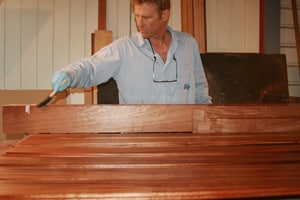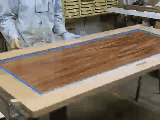SEPT 1, 2015 UPDATE: This blog post was written in 2010. Waterlox changed their formula. I no longer use and recommend this product. I’m still researching to find a great replacement. ~ Allan Little


In woodworking, sanding and finishing go hand in hand. Sanding through the sequence of grits until there are no machine marks and the wood is polished, a.k.a. Sanding The Sequence, is the key to making even average wood look it’s best. And when you apply the penetrating Waterlox finish, great results are guaranteed. But before you apply, be sure to clean the surface really well in order to keep from trapping particles in this amazing, crystal clear finish.
A well sanded and finished 2×4 stud looks better to me than a piece of rosewood with planner ripple and sanding swirl marks covered in a polyurethane finish. ~ Allan Little
When I started making this frame and panel solid wood sipo door, I decided it was the perfect project to document my finishing, sanding, gluing and clamping techniques to share.

The finish that I have used almost exclusively for the last twenty plus years is Waterlox Original. In the series of videos below, I will show step by step how to produce a spectacular finish in a very low-tech, low overhead manner. Every aspect of producing this unmatched finish is covered; from sanding, surface preparation, application of the finish, and scratching or etching between multiple coats.  I also show a very unique way I suspend the door horizontally on an inexpensive shop made rotisserie mechanism that allows all surfaces of the door to be finished without handling.
I also show a very unique way I suspend the door horizontally on an inexpensive shop made rotisserie mechanism that allows all surfaces of the door to be finished without handling.
In the photo at the top of this post you will see why I love the Waterlox finish. The genuine mahogany bedside table was built and finished over fifteen years ago and I haven’t touched the finish since. Since Waterlox reveals the natural color of the wood, the only apparent difference of these finishes is that one is redder than the other. Sipo, also known as African mahogany, is naturally browner while genuine mahogany is a warmer, redder color. The mahogany table has darkened substantially over the years, but this tung oil based finish has held up perfectly.
NOTE: It’s important to note, that while Waterlox Original Finish is tung oil based it is NOT pure tung oil. Waterlox is a specially processed tung oil and you will not get the same results if you buy basic tung oil from your hardware store.
Hope you find these videos helpful. You can watch the whole series as well as many other woodworking videos on my YouTube channel. There are a total of 17 for this woodworking project.
If you want to be notified each time I upload a new video, visit my YouTube channel: AskWoodman.TV and hit subscribe. If you don’t have a YouTube account, you have the option of signing up to my blog in the box on the top right of my site. Or you can create a YouTube account and subscribe to both!